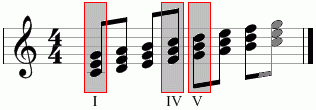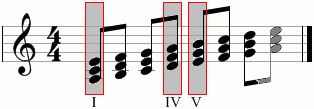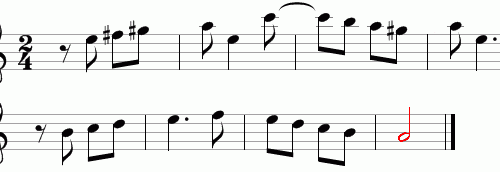
Main triads of major and minor
Contents
What are the most popular chord progressions found in songs?
Major triads in major
You can build triads on all degrees of major. Recall that the intervals between adjacent notes of a triad must be a third . When building triads from the steps of the mode, it is allowed to use only those sounds that are included in the mode in question. For example, consider C-dur . We build a triad, from the note E. Choices of triads are possible:
- Major: EG♯ – H
- Minor: EGH
- Reduced: EGB
- Enlarged : EG♯ – H♯
We see that only in the minor triad there are no signs of alteration. The other three must have a sharp or a flat. Since the scale we are considering does not contain notes with sharps or flats, we can choose only a minor triad (without accidentals).
According to this principle, we will build triads from each step of the major scale (using the exampleC major):

Figure 1. Main triads in major
In the figure, a triad is built from each step. Frames highlight steps (I, IV and V, these are the main steps), from which major triads are built. These are the main triads, they have individual names:
- Triad built from the I degree: tonic. Designated: T.
- Triad built from the fourth degree: subdominant. Designated: S.
- Triad built from the 5th degree: dominant. Designated: D.
We pay attention once again: all three main triads are major. They most correspond to the sound of the major mode: both the major mode and the major triads.
The main triads are built from I, IV and V steps.
Major triads in minor
Similarly, we build triads in minor. Minor triads will be located on the main steps. The names of triads are the same as in major, only they are indicated by small letters: t, s, d. The figure below showsA minor:

Figure 2. Major triads in minor
In practice, the dominant triad is almost always used with the raised 7th degree of the minor, that is, the third of the chord. Thus, instead of mi-sol-si, we will most likely hear mi-sol-sharp-si in music. Such a triad helps the music move forward, develop:

Figure 3. Major triads in minor
The main triads are built from I, IV and V steps.
Connecting chords
A combination of (two) chords is their sequence in a piece of music. A sequence of several chords is called a harmonic revolution .
The main triads are the harmonic basis of the mode. They are very widespread in music. It is useful to know their simplest connections, here is a list for major and minor.
Results
You got acquainted with the main triads of the major and minor modes. We built them from I, IV and V steps. Pay attention to their simplest connections.





